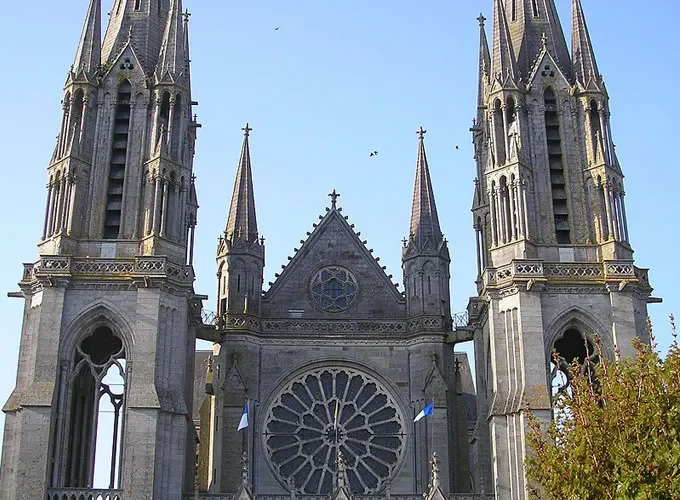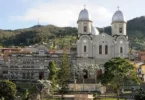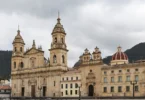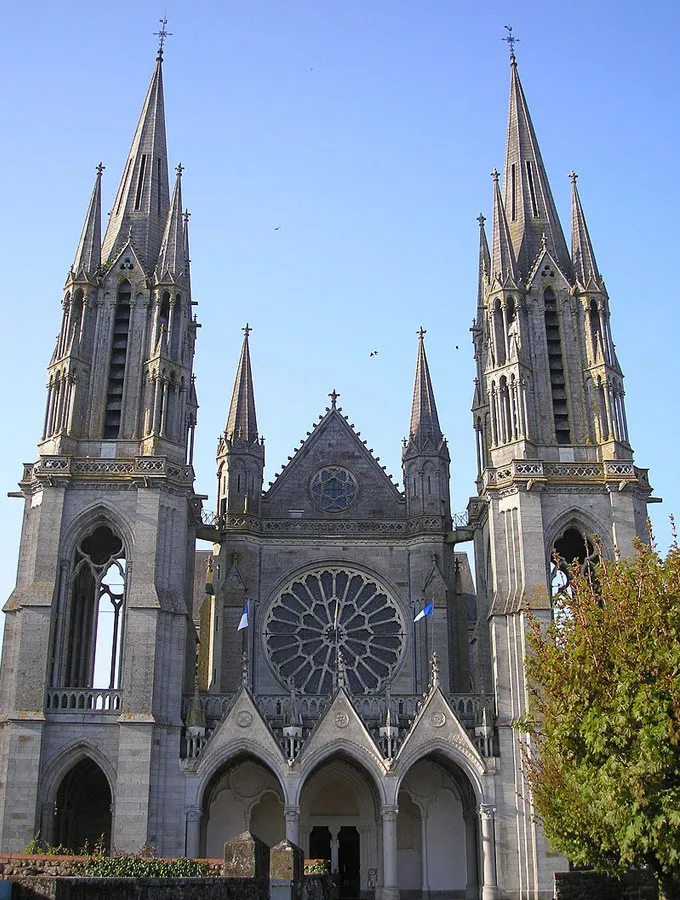
Introduction
The Notre-Dame de Pontmain basilica, also called the Notre-Dame de l’Espérance de Pontmain basilica (Basilica of Our Lady of Hope in Pontmain, France) was built at the end of the 19th century in Pontmain, near the site of the Marian apparition of Pontmain on 17th January 1871. Consecrated in 1900, it was elevated to the rank of minor basilica in 1905.
Built in granite in the neo-Gothic style, it has large colored windows, made over the decades (the latest date from the end of the 20th century). Two towers house a carillon of 39 bells.
Architecture of Basilica of Our Lady of Hope in Pontmain, France
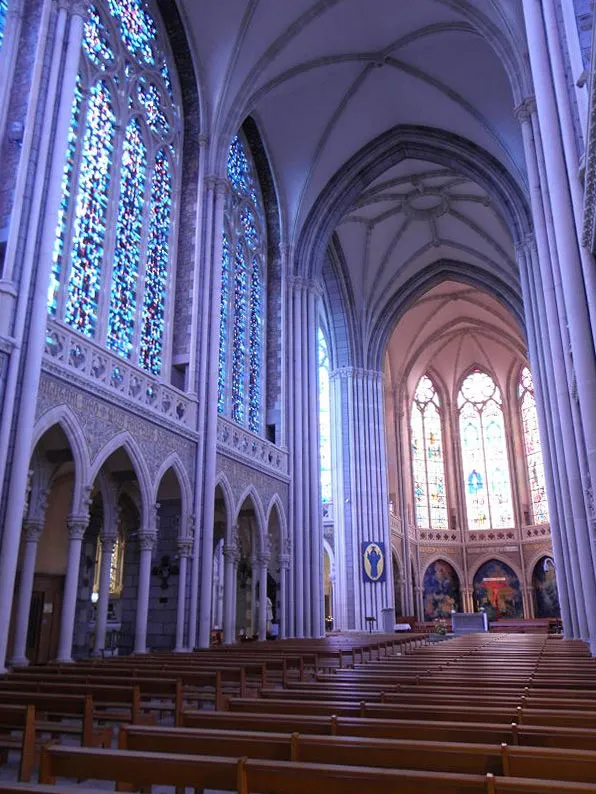
Following the apparition and its canonical recognition, the Abbé Guérin, parish priest of Pontmain, ensured the reception of pilgrims with the nuns of the school. But after his death in 1872, the bishop called the Missionary Oblates of Mary Immaculate to animate the first pilgrimages and to preach in the region. The influx of pilgrims to Pontmain is increasing rapidly, hence the need to build a sanctuary. Bishop Wicart asked the architects for a church that could accommodate 1,000 people (today the site can accommodate 1,280 people).
- Bishop Wicart, Bishop of Laval, lays the first stone of the Basilica of Pontmain on 17th June 1873, but dies soon after.
- The church was completed in 1893, but it was not consecrated until 1894, on 15th October, 1900 the church was consectreated by Bishop Pierre Geay.
- On 21st February 1905, Pope Pius X raised the sanctuary of Pontmain to the rank of minor basilica and attached it to Sainte-Marie-Majeure.
- On 22nd, 23rd & 24th September 1908 the church is solemnly proclaimed “Basilica of Our Lady of Hope of Pontmain”, in the presence of two archbishops, four bishops, 600 priests and 15,000 pilgrims.
- In 1946 the ceremonies for the 75th anniversary of the apparition, presided over by the Apostolic Nuncio Mgr Roncalli, future Pope John XXIII.
- This basilica participates in the revival of the Marian cult, attested by the process of “sacral recharging” of the pilgrimage sanctuaries shaken by the contestation of the Age of Enlightenment.
Pilgrimages
From the first days following the apparition, even before the opinion of the Church on the authenticity or not of the apparition, pilgrims go to the place to pray there because they see in the rapid departure of the troops Germans of the department (in the days following the apparition), the sign of the protection of the Virgin. This is why spontaneous pilgrimages were immediately organized in Pontmain. Abbé Richard will count the March 2 (a little over a month after the apparition), about 400 pilgrims in the village. In the spring, there are already between 3,000 and 4,000 people a day.
Following the apparition and its canonical recognition, the Abbé Guérin, parish priest of Pontmain, ensured the reception of pilgrims with the nuns of the school. But after his death in 1872, the bishop called the Missionary Oblates of Mary Immaculate to animate the first pilgrimages and to preach in the region. The influx of pilgrims to Pontmain was rapid. For the first anniversary of the apparitions, the 17th January 1872, there were already 8,000 people. Coming first from the department, the pilgrims gradually come from all over France, then from abroad.
In 1903, the Oblates were expelled from France, following the policy of separation of Church and State. They would not return until after World War I. During this interval, it is the village priest who takes care of the pilgrims. The Oblates are still present today and welcome pilgrims to the Oblates’ house in Pontmain, a former juniorate and novitiate of the congregation. Today there are approximately 300,000 pilgrims per year and 4,000 pilgrims (per day) during major feasts (such as the Assumption).
17th January 2021, the sanctuary has celebrated the 150th anniversary of the apparition with special festivities.
The Church
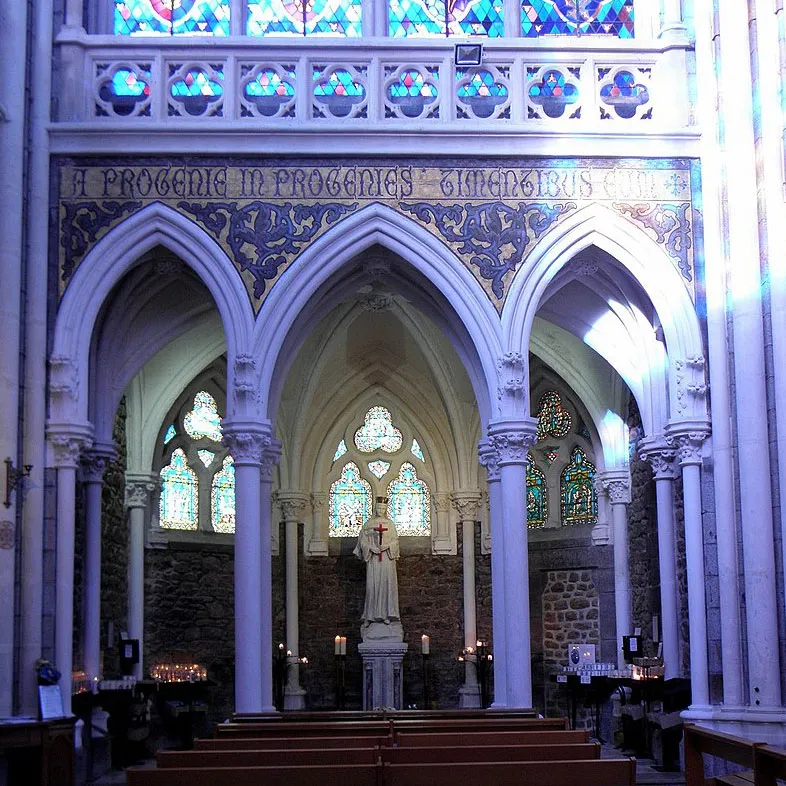
The church was built on a swamp. To prevent the building from collapsing, the builders sought to lighten its structure. This is why the stones stop at the first floor, and are then followed by large stained glass windows. The church can now accommodate 1,280 people, and the esplanade in front of the building can bring together several thousand pilgrims during major celebrations.
The building, in neo-Gothic style, is built entirely of granite. It is not oriented east-west but turned towards the house of the apparition. Its nave is separated from the aisles by strong pillars, and it ends in a chancel with canted sides. The two spiers of the basilica, which house 39 bells, are visible more than 10 km from Pontmain.
The Stained Glass Windows
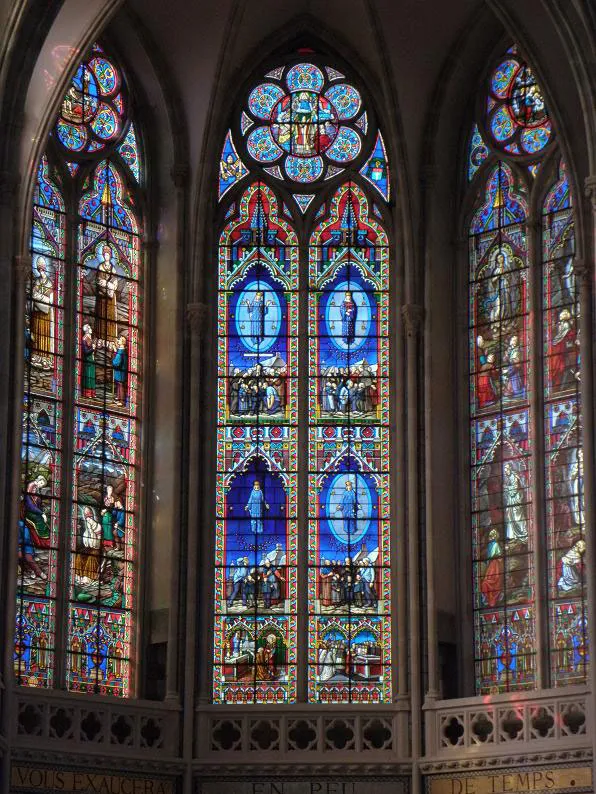
Inside, ten large windows depicting Marian apparitions in France (at La Salette, Lourdes and Pontmain) and scenes from the life of Jesus Christ. The stained glass windows were made in five successive periods :
- From 1874 to 1887 by the master glassmaker Édouard Rathouis, in the workshops of the Carmel of Le Mans : stained glass windows in the choir and stained glass windows at the back of the chapels of the transepts.
- From 1897 to 1898 by master glassmaker Alleaume, from Laval : stained glass windows in the side chapels, except for those in one chapel which are by master glassmaker Fournier from Tours. We see in particular the red crosses of the apparition.
- In 1955 by the master glassmakers of Rennes Paul and André Rault, the large windows of the Art Deco style transepts.
- From 1966 to 1978 by master glassmaker Maurice Rocher, from Paris, by the Degusseau workshops in Orléans: stained glass windows in the nave (non-figurative style influenced by Cubism). She plays on the different blues (37 in total), because “the blue of the Virgin [during the apparition] was not identifiable by the seers”.
- In 1998 by master glassmaker Bernard Renonce: the rosette (non-figurative style). This creation is embraced by the shapes of the organ case.
The Organ
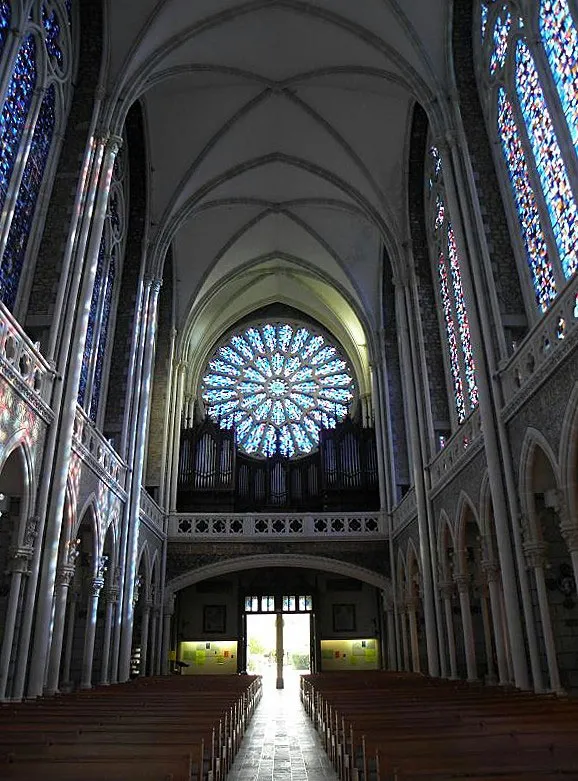
The great gallery organ was built in 1931 by organ builder Gloton-Debierre and was repaired in 1960 by Beuchet-Debierre.
It has 34 sets, with electro-pneumatic transmissions. The buffet, in neo-Gothic style, occupies the entire width of the nave; it was designed to completely clear the view of the large front rosette in front of which the instrument is placed.
A restoration is planned from 2020, with a call for donations to finance it.
The Chime
The Towers of the Pontmain Basilica house a carillon of 39 bells, the 5 largest of which are peals. Originally equipped with 25 bells cast in 1896 by the Paccard foundry in Annecy-le-Vieux, the carillon was successively increased to 32, 37 and then 39 bells.
Our Lady of Pontmain
Our Lady of Pontmain, also known as Our Lady of Hope, is the title given to the Virgin Mary following her apparition at Pontmain, France on 17 January 1871.
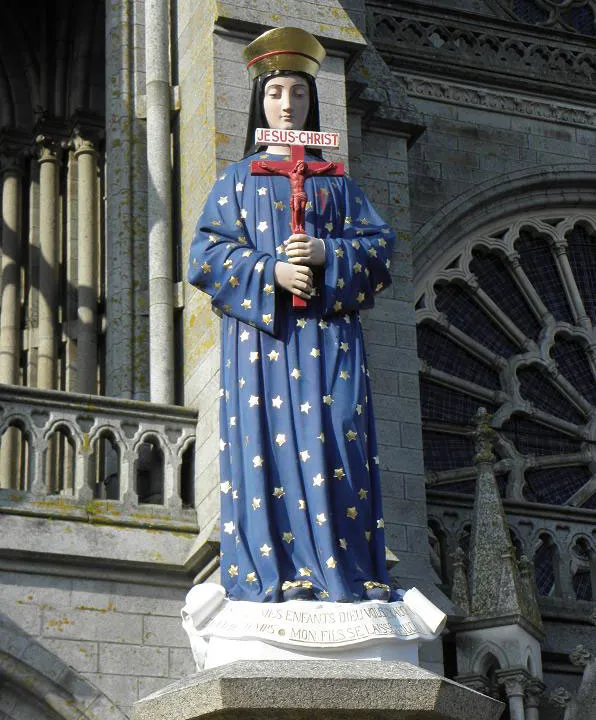
The Apparition
The Franco-Prussian War (also called the War of 1870) was the culmination of years of tension between the two nations, which finally came to a head on 19 July 1870, when Emperor Napoleon III of the Second Empire declared war against Prussia. From the first days of the war, defeat followed defeat. By January 1871, Paris was under siege, while two-thirds of the country was under the advancing Prussians.
The apparition is said to have occurred at the height of the war. Pontmain, a hamlet of about 500 inhabitants, lay between the oncoming Prussian army and the city of Laval. The local Barbedette family consisted of father César, his wife, Victoire, with their two sons Joseph and Eugène, aged ten and twelve, and another older boy who was away in the army.
On the evening of 17 January 1871, the two boys were helping their father in the barn when the elder, Eugène, walked over towards the door to look out. As he gazed at the star-studded sky, he suddenly saw an apparition of a beautiful woman smiling at him; she was wearing a blue gown covered with golden stars, and a black veil under a golden crown.
His father, brother, and a neighbour came out to look and Joseph immediately said he too could see the apparition although the adults saw nothing. The mother, Victoire, came out but she too could see nothing. The boys’ parents could not see what their children were seeing that night and called for Sister Vitaline, the local school teacher.
She, like the boys’ parents, could also not see the apparition, and called for two girls, Françoise Richer and Jeanne-Marie Lebosse, aged nine and eleven, respectively. Sister Vitaline suggested that perhaps Our Lady was visible only to the children. Without any prior knowledge of the apparition, the girls looked into the night sky and began describing the vision in exactly the same detail as the Barbedette boys did.
A crowd gathered to pray as word quickly spread among the anxious villagers. Children saw the beautiful Lady, and gleefully pointed up to her. Adults, however, only saw three stars forming a triangle. As they prayed the Rosary, the children saw the garment’s stars multiply until it was almost entirely gold. Next, the children saw a banner unfurl beneath the Lady. Slowly, a message appeared: But pray, my children.
God will hear you in time. My Son allows Himself to be touched. Upon hearing the message read aloud, the crowd spontaneously began the hymn “Mother of Hope”. As they sang, the Lady laughed and joined in the singing. The children squealed with delight as her hands kept time with the music. When the crowd began “My Sweet Jesus,” her expression changed to profound sadness and a red crucifix appeared in her hands, with the words “Jesus Christ” above it.
Her eyes mournfully contemplated the crucifix during the hymn. As the people sang “Ave Maris Stella”, the crucifix vanished and her smile returned, though with a touch of melancholy. Two small white crosses then appeared on her shoulders before the Lady disappeared behind a cloud. As the night’s prayers came to a close, the apparition ended. It was about nine o’clock; the phenomenon had lasted about three hours.
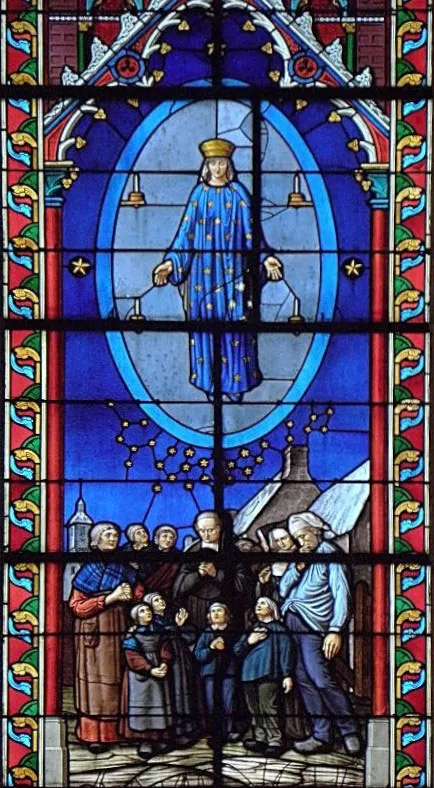
Description of the Lady
Years later, Joseph Barbadette, who later became a priest of the Congregation of the Oblates of Mary Immaculate, recounted:
She was young and tall of stature, clad in a garment of deep blue, her dress was covered with brilliant gold stars. The sleeves were ample and long. She wore slippers of the same blue as the dress, ornamented with gold bows. On the head was a black veil half covering the forehead, concealing the hair and ears, and falling over the shoulders.
Above this was a crown resembling a diadem, higher in front than elsewhere, and widening out at the sides. A red line encircled the crown at the middle. Her hands were small and extended toward us as in the ‘Miraculous Medal.’ Her face had the most exquisite delicacy and a smile of ineffable sweetness. The eyes, of unutterable tenderness, were fixed on us. Like a true mother, she seemed happier in looking at us than we in contemplating.
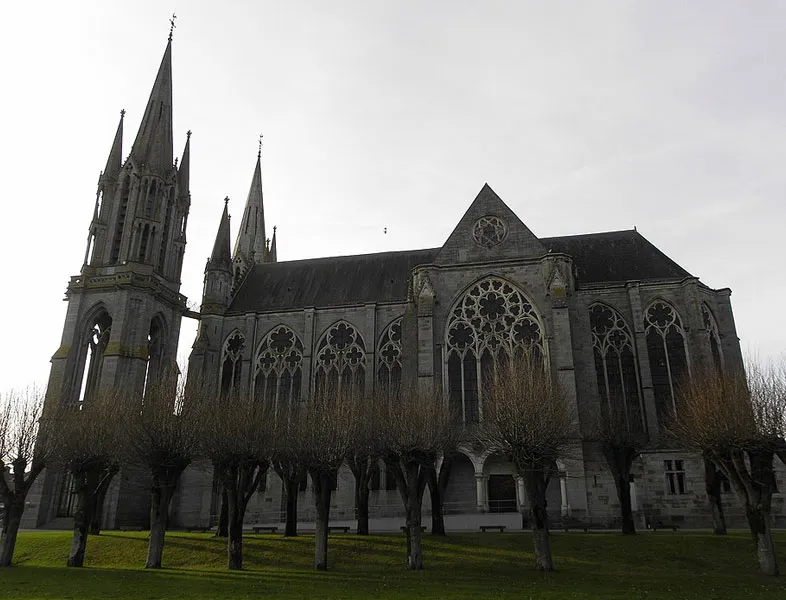
After the Apparition
That same evening, Prussian forces inexplicably abandoned their advance. General von Schmidt of the Prussian Army, who was about to move on the city of Laval towards Pontmain, received orders from his commander not to take the city. On the evening of 17 January 1871, the Commander of the Prussian forces, having taken up his quarters at the archiepiscopal palace of Le Mans, told Msgr. Fillion, Bishop of that diocese: “By this time my troops are at Laval”.
On the same evening, the Prussian troops in sight of Laval stopped at half-past five o’clock, about the time when the apparition first appeared above Pontmain, a few miles off. General Schmidt is reported to have said on the morning of the 18th: “We cannot go farther. Yonder, in the direction of Brittany, there is an invisible ‘Madonna’ barring the way.”
The sudden stopping of the Prussian forces in sight of Laval, and their retirement the following morning, meant, together with the saving of Brittany, the turning back of the tide of conquering soldiery from that part of France. The war was practically at an end. On 23 January 1871, the long-hoped for armistice was signed. Soon, all thirty-eight conscripted men and boys returned home unscathed.
Authorization of Our Lady of Hope
After that the devotion to the Blessed Virgin under the title of that of Notre Dame d’Esperance de Pontmain, “Our Lady of Hope of Pontmain”, was authorized by ecclesiastical authorities, and the confraternity of that name has been extended all over the world.
After the apparition of “Our Lady of Hope” on 17 January 1871, pilgrims made up of both the clergy and the laity came to Pontmain. At the same time, inquiries and investigations were made about the apparition; the visionary children were submitted to various intense interrogations. Finally, on the Feast of the Purification, 2 February 1872, Msgr. Wicart, Bishop of Laval, issued a pastoral letter giving canonical judgment on the apparition. Thus, the veneration of Our Lady of Hope of Pontmain was given official Church recognition and approval.
Joseph Barbadette became a priest of the Congregation of the Oblates of Mary Immaculate; his brother Eugène became a secular priest. His housekeeper was one of the girls who had seen the apparition with him, and the other, Jeanne-Marie Lebossé, became a nun.
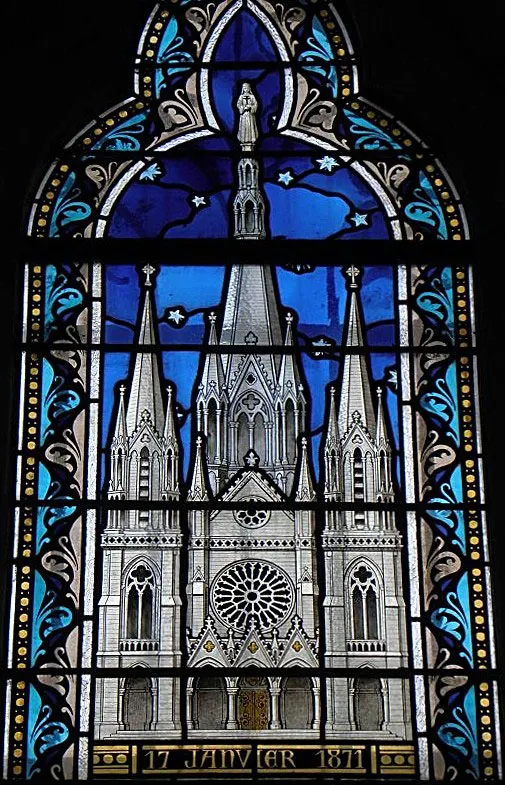
Veneration
In May 1872, Bishop Wicart authorized the construction of a shrine, which was consecrated in October 1900. In 1905, Pope Saint Pius X elevated the Sanctuary to the status of a minor basilica.
Pope Pius XI gave a final decision regarding the Mass and Office in honor of Our Lady of Hope of Pontmain. A final papal honour was given to Our Lady of Hope on 16 July 1932 by Cardinal Pacelli, who later became Pope Pius XII, by passing a decree from the Chapter of St. Peter’s Basilica that the statue of the Blessed Lady, Mother of Hope, be solemnly honoured with the crown of gold.
The Lady then was crowned in the presence of bishops, priests, and the laity by Cardinal Verdier, Archbishop of Paris on 24 July 1934. During the Second World War, Our Lady of Pontmain was prayed to in the hope that she would bring peace in France.
At Pontmain, it was a matter of a message of prayer, very simple in the dramatic circumstances of war and invasion. At Pontmain, Mary is a sign of hope in the midst of war. A place of pilgrimage, it attracts annually around 200,000 drawn from among the people of the region, with some international pilgrimages, especially from Germany.
Notre-Dame-de-Pontmain, Quebec is a municipality in Canada that was named after the apparition. Our Lady of Hope is a parish of the Roman Catholic Diocese of Sault Sainte Marie in Sudbury, Ontario, Canada. There is a chapel dedicated to Our Lady of Hope of Pontmain at the National Shrine of the Immaculate Conception in Washington, D.C. Funds for this chapel were donated by Bob Hope and his wife Dolores.
Feast Day - 17th January
Annual Feast Day of Our Lady of Pontmain held on 17th January.
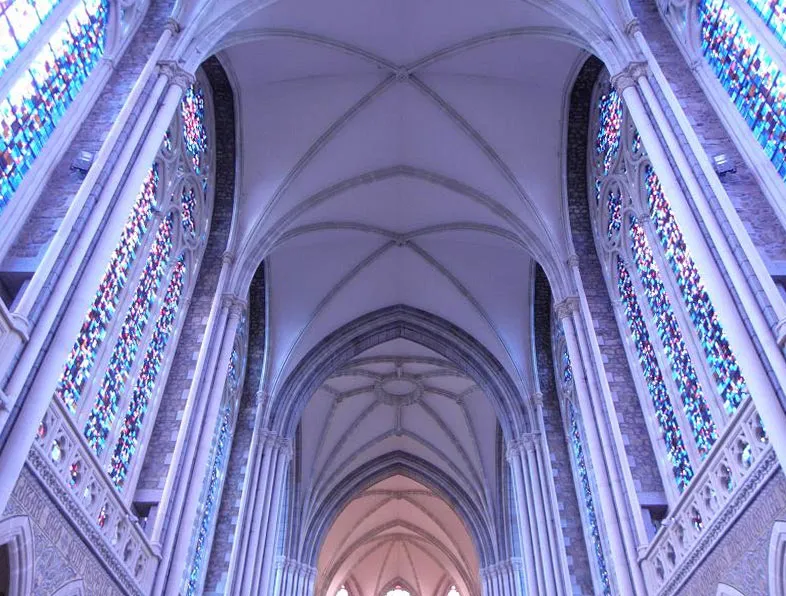
Mass Time
Weekdays
- 11:00 am
Sundays
- 10:30 am
- 5:00 pm
Church Visiting Time
- Every Days : 7:00 am to 7:00 pm
Contact Info
Basilique Notre-Dame,
3 Rue Notre Dame,
53220, Pontmain, France.
Phone No.
Tel : +02 43 05 07 26
Accommodations
How to reach the Basilica
Châteaubriant – Pouancé Airport at Ombrée d’Anjou, France is the nearby airport to the Basilica.
Gare Pontorson – Mont-Saint-Michel Train station in Pontorson, France is the nearby Train Station to the Basilica.

